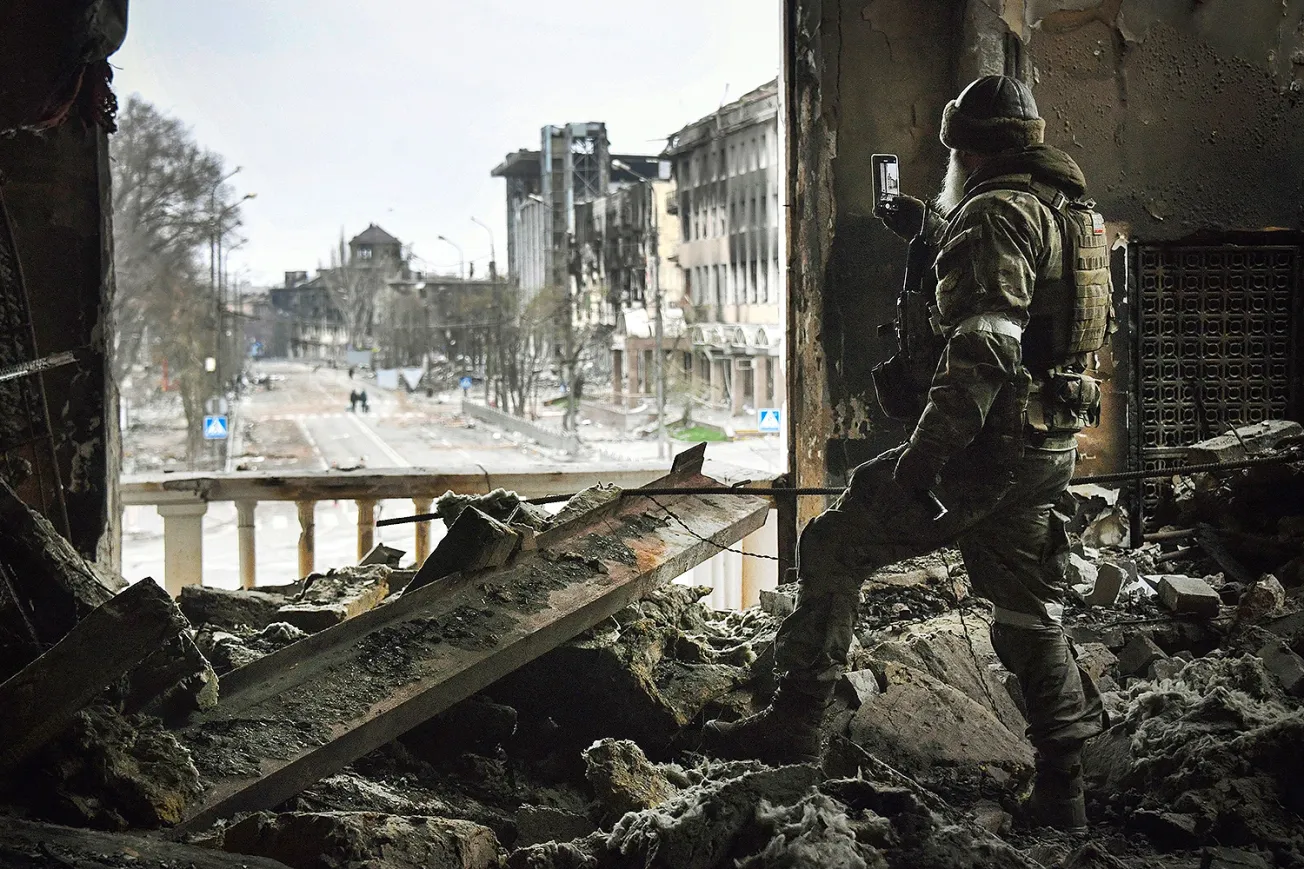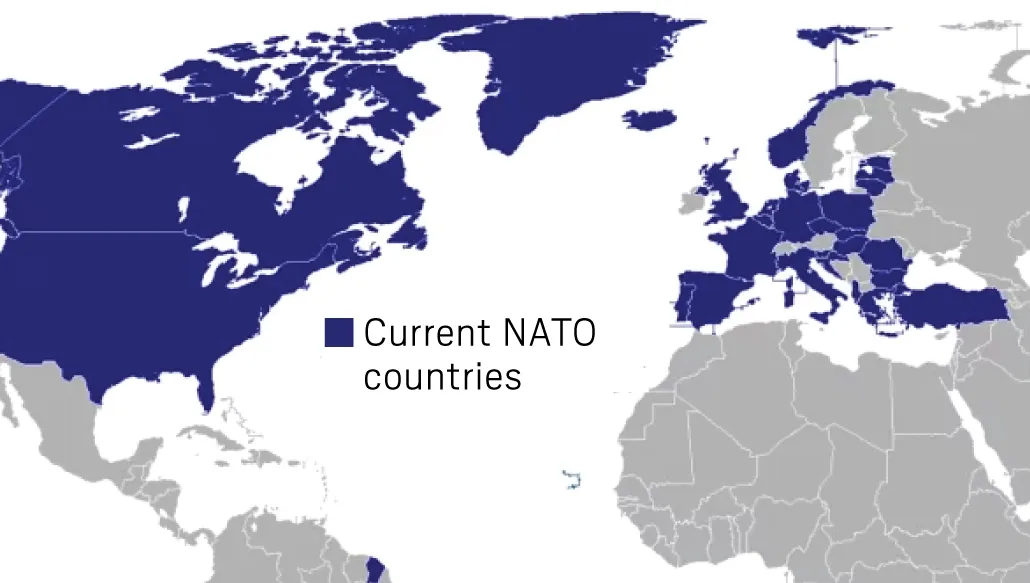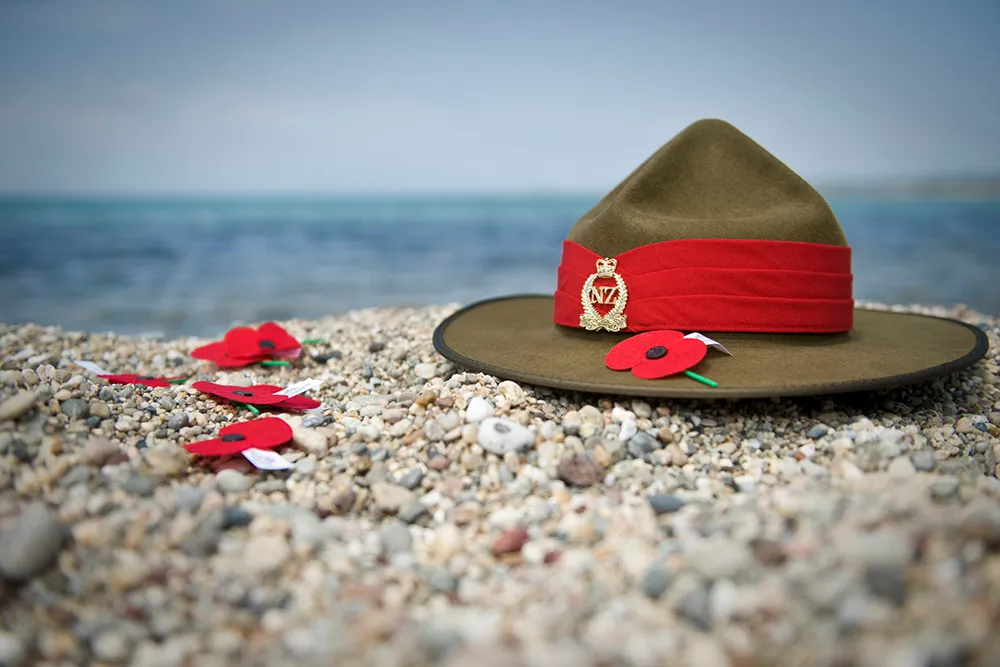Patrick Lawrence

Let us consider the following paragraphs, which appear in the May 29 edition of the New Yorker:
While Tynda and his team were fighting from the trench, long and powerful fusillades had issued from another Ukrainian position, on a hilltop behind them. I later went there with Tynda. In a blind overlooking the no man’s land stood an improbably antique contraption on iron wheels: a Maxim gun, the first fully automatic weapon ever made. Although this particular model dated from 1945, it was virtually identical to the original version, which was invented in 1884: a knobbed crank handle, wooden grips, a lidded compartment for adding cold water or snow when the barrel overheated. …
In the course of the past year, the US has furnished Ukraine with more than thirty-five billion dollars in security assistance. Why, given the American largesse, had the 28th Brigade resorted to such a museum piece? A lot of equipment has been damaged or destroyed on the battlefield. At the same time, Ukraine appears to have forgone refitting debilitated units in order to stockpile for a large-scale offensive that is meant to take place later this spring. At least eight new brigades have been formed from scratch to spearhead the campaign. While these units have been receiving weapons, tanks, and training from the US and Europe, veteran brigades like the 28th have had to hold the line with the dregs of a critically depleted arsenal.
The piece, from which this passage is drawn, carries the headline, “Two Weeks at the Front in Ukraine” and is the work of Luke Mogelson, a magazine correspondent of a dozen or so years’ experience. Mogelson’s text is accompanied by the photographs of Maxim Dondyuk, a Ukrainian of roughly Mogelson’s age, either side of 40, whose work focuses on history and memory, topics that suggest a lot of thought goes into those 1/1000ths of a second when Dondyuk clicks his shutter.
There are many things to think about and say as we read this piece. I will shortly have more to say about the excellence of Mogelson’s text and Dondyuk’s photographs. For now, the first thing to note is that, after 15 months of conflict, their work suggests Western media may at last begin to cover the Ukraine war properly. I will stay with the conditional verb for now, but this could mark a significant turn not only for the profession – which could use a significant turn, heaven knows – but also in public support for the US–NATO proxy war against the Russian Federation.
As astute readers will already know, apart from a few staged forays near the front lines – officially controlled and monitored, never at the front lines – correspondents from the New York Times, the other big dailies, the wire services, and the broadcast networks have accepted without protest the Kyiv regime’s refusal to allow them to see the war as it is. Content these professional slovens have been to sit in Kyiv hotel rooms and file stories based on the regime’s transparently unreliable accounts of events, all the while pretending their stories are properly reported and factual.
The exceptions here are Times correspondents such as Carlotta Gall, whose Russophobia seems reliably unbalanced enough to satisfy the Kyiv regime, and the two Andrews, Higgins and Kramer, who have an exquisite talent for stories that make absolutely no sense. It was the two Andrews, you may recall, who had the Russians shelling the nuclear power plant they occupied and, later on, bombing their own prisoner-of-war camp in eastern Ukraine.
If correspondents cannot see the war and it makes no matter to them, we will not see it either. The result, as your columnist noted a while ago, has been two wars: There is the presented war, the mythical war, and the real war. “Our current brainwashing for war is similar to that preceding other wars,” John Pilger, the journalist and filmmaker, wrote in a Tweet the other day, “but never, in my experience as a war correspondent, as unrelenting or bereft of honest journalism”.
This is what makes Mogelson’s file so startling. In its graphic honesty it is a major step on from the gruel of propaganda corporate media have fed us since the Russian intervention began in February 2022. Those three Times correspondents just mentioned? They all have many years’ experience on Mogelson. None of them could change his typewriter ribbon, as we used to say.
Mogelson and Dondyuk spent two weeks this past March with a Ukrainian infantry battalion as it fought in trenches “at a small Army position in the eastern region of the Donbas, where shock waves and shrapnel had reduced the surrounding trees to splintered canes”. This was just outside a village south of Bakhmut, the much-embattled city lately lost to Russian forces. I have no doubt these two journalists were officially embedded with the high command’s approval. That is the way the Kyiv regime is running this war. But, for whatever reason – and I will get to this question in a sec – there is no whiff of inhibition or self-censorship in either the reportage or the photographs. Both are raw, unflattering, as unforgiving as the scenes they depict:
By the time I joined the battalion, about two months had passed since it had lost the battle for the village, and during the interim, neither side had attempted a major operation against the other. It was all the Ukrainians could do to maintain the stalemate. Pavlo estimated that, owing to the casualties his unit had sustained, eighty percent of his men were new draftees. “They’re civilians with no experience,” he said. “If they give me ten, I’m lucky when three of them can fight.”
We were in his bunker, which had been dug in the back yard of a half-demolished farmhouse; the constant rumble of artillery vibrated through the dirt walls. “A lot of the new guys don’t have the stamina to be out here,” Pavlo said. “They get scared and they panic.” His military call sign was Cranky, and he was renowned for his temper, but he spoke sympathetically about his weaker soldiers and their fears. Even for him, a career officer of twenty-three years, this phase of the war had been harrowing.On a road that passed in front of the farmhouse, a board had been nailed to a tree with the painted words “to moscow” and an arrow pointing east. No one knew who’d put it there. Such optimistic brio seemed to be a vestige of another time.
Mogelson then introduces us to others in the battalion:
Just two of the soldiers who were rebuilding the machine-gun nest had been with the battalion since Kherson. One of them, a twenty-nine-year-old construction worker called Bison—because he was built like one—had been hospitalized three times: after being shot in the shoulder, after being wounded by shrapnel in the ankle and knee, and after being wounded by shrapnel in the back and arm. The other veteran, code-named Odesa, had enlisted in the Army in 2015, after dropping out of college. Short and stocky, he had the same serene deportment as Bison. The uncanny extent to which both men had adapted to their lethal environment underscored the agitation of the recent arrivals, who flinched whenever something whistled overhead or crashed nearby.
“I only trust Bison,” Odesa said. “If the new recruits run away, it will mean immediate death for us.” He’d lost nearly all his closest friends in Kherson. Taking out his phone, he swiped through a series of photographs: “Killed . . . killed . . . killed . . . killed . . . killed . . . wounded. . . . Now I have to get used to different people. It’s like starting over.” Because the high attrition rate had disproportionately affected the bravest and most aggressive soldiers – a phenomenon that one officer called “reverse natural selection” – seasoned infantrymen like Odesa and Bison were extremely valuable and extremely fatigued. After Kherson, Odesa had gone awol. “I was in a bad place psychologically,” he said. “I needed a break.” After two months of resting and recuperating at home, he came back. His return was prompted not by a fear of being punished – what were they going to do, put him in the trenches? – but by a sense of loyalty to his dead friends. “I felt guilty,” he said. “I realized that my place was here.”
Reporting and writing of this caliber makes Mogelson look the dazzling star next to the correspondent-reenactors in their Kyiv hotel rooms. But for my money he also keeps pace with a lot of standout names from the past. I see in his copy a little Dexter Filkins, a little Bernard Fall, a little Michael Herr, a little Martha Gellhorn, and I’ll go so far as to say a little Ernie Pyle. As for Dondyuk’s pictures, the way they leap off the page brings to mind Tim Page, Horst Faas, Robert Kapa, and some of the other great war fotogs of their day. If this piece portends a turn or return (however you want to think of it) to reporting with some integrity to it, the project could not have got off to a better start. But let us stay with “if” for now.
There are at bottom two kinds of journalists: There are the analysts, as I call them, who add an interpretive dimension to their coverage – understanding in addition to knowledge. And there are the reporters, empiricists in the just-the-facts vein who stay close to the ground and do not much dolly out for any kind of larger take. Mogelson is of this latter type. Reporters of his sort invite us to infer from what they tell us. What shall we infer from superbly tactile, eye-of-the-camera reportage?
Luke Mogelson is not telling us about an army on the way to victory – or an army that pretends to itself it is on the way to victory, or one that wants the world to think it is on the way to victory. There are no battlefield successes, no advances, no high expectations in Mogelson’s story. There is “holding the line”, although few seem to hold, and there is staying alive. This is a story more given to severe attrition among soldiers waiting for the end and wondering how distant in time the end will prove.
In Mogelson’s writing we meet conscripts sent to the front after little or no training. He describes one man who was kidnapped on a city sidewalk and was under Russian fire three days later. Paralyzing fright, exhaustion, demoralization, desertions, a sort of Beetle Bailey incompetence – these are rampant among the green draftees that now make up the majority of the AFU’s infantry. They fight with Vietnam-era vehicles shipped from the US, or muzzle-loaded mortars long out of production, or Soviet-era weapons left over from the pre-1991 days – and, withal, too little ammunition for this kind of matériel to make any difference at all.
A 1945 Maxim gun of 1884 design? Jeez. Mogelson is right to question, if too briefly, where may be all the weapons the US and NATO allies are shipping into Ukraine. A great number of them have already been destroyed, he reports, which comes as no surprise. Being as close to the scene as he put himself earlier this spring, he would have done well to tell us something about the greedheads who run the regime and the military as they sell shocking amounts of arms into the black market as soon as they arrive across the Polish border.
At one point Mogelson and Dondyuk spend a day in a dugout with a seasoned sergeant named Kaban and a 19-year-old codenamed Cadet, so young he hasn’t lost his baby fat. “Later, Kaban entertained us with stories about his past romantic escapades,” Mogelson recounts, “and Dondyuk, the photographer, asked him whether he’d imparted any lessons to Cadet.
“‘There’s no point,’ Kaban said. ‘He’ll be dead soon.’
“Cadet laughed, but Kaban didn’t.”
These are the voices of the war Mogelson tells us about. Can’t you just cut the anxiety in Cadet’s laugh with a knife?
I have to mention some wonderful touches in Mogelson’s report because they are superlative writing of the kind that is too rare these days. Of the soldier firing that Maxim gun: “The gun’s operator, a rawboned soccer hooligan with brass knuckles tattooed on his hand, spoke of the Maxim like a car enthusiast lauding the performance of a vintage Mustang.” Describing an unwieldy personnel carrier of Vietnam vintage, Mogelson tells us: “It looked like a green metal box on tracks… The maxed-out machine sounded like a blender full of silverware.”
Did Gellhorn do any better as she covered of the Spanish Civil War for Colliers?
Mogelson shows us the war a few independent journalists have written of but a war we have not heretofore read about in mainstream media. This is the war the propaganda machine has kept from us. And now we know that what correspondents reporting for independent media have been describing is by and large the war as it is. Among much else we can now see the obvious indifference the Kyiv regime and its Western backers display for those doing the fighting – who, Mogelson tells us, are now working-class Ukrainians, the more privileged having dodged the draft or otherwise avoided service.
Mogelson reported this piece in March, and we can justly assume conditions on the front line of this war are now three months’ worth of worse. His report makes me want to bang my shoe on the table, Khrushchev-style, in equal measure for the disgraceful conduct of mainstreamers reenacting the work of correspondents, for the senseless loss of Ukrainian lives in the service of the presented war, and for the AFU soldiers – veterans and the untrained draftees they command – who the Kyiv regime has not quite but nearly abandoned.
The obvious question is why this piece appears now in the New Yorker, a magazine thoroughly committed to every liberal orthodoxy you can think of, including the wisdom of this war and the certainty of an AFU victory. Hell broke loose last year, you will recall, when Amnesty International and then CBS News lifted the lid on the realities of the Ukraine conflict. What is different now?
This is hard to say. But the larger picture suggests publication of this eye- and mind-opening piece reflects a creeping recognition in all sorts of places – among the policy cliques, at the Pentagon, in corporate media – that Ukraine is not going to win this war and the time has come to prepare for this eventuality. The new drift on the vaunted counteroffensive is that it is not going to make much difference. There is more talk now about the conditions necessary to begin negotiations. NATO officials, per Steven Erlanger, The Times’s Brussels correspondent, are now thinking about doing in Ukraine what the allies did in postwar Germany: Divide it such that the west joins the alliance and the east is left to the East, so to say.
Mogelson’s intent, surely, was to do good work, full stop, and he has. But read in this larger context, its publication looks to me the start of an effort to get all those people with blue-and-yellow flags on their front porches ready for a dose of the reality from which they have been shielded all these months. The Wall Street Journal, the New York Post, Business Insider, Forbes: They have all recently run pieces not nearly as good as Mogelson’s but in the let’s-get-real line.
If I am right, the real war and the presented war will eventually be one. About time, I would say. Not that mainstream media are about to ’fess up to their sins and disgraces in their pitiful coverage of this war. They never will. Let us not get carried away on this point.
Reprinted with permission from SheerPost.









